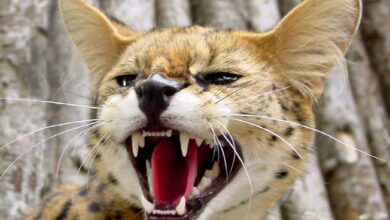Jaguarundi – eyra cat (Puma yagouaroundi)
It resembles a weasel, but it’s only an illusion – the jaguarundi is a South American representative of felids whose build and temperament can surprise you. Although it seems to be feisty, it is shy and cautious.
Classification
- Kingdom: Animalia
- Class: Mammalia
- Order: Carnivora
- Family: Felidae
- Genus: Puma
- Species: Puma yagouaroundi
- Synonyms:
- Felis yagouaroundi
- Herpailurus yagouaroundi

Occurrence and habitat
The jaguarundi inhabits regions of Central and South America east of the Andes, up to north-central Argentina. It can also be found in southern Texas and on the coast of northern Mexico, but this information hasn’t been confirmed.
Habitats of the jaguarundi include lowland areas near water bodies, dry thorn forests, wet grasslands and dense tropical forests. Although it is commonly found on lowland areas, there have been reports on the jaguarundi found at the altitudes between 2,000 and 3,200 m (6,560 and 10,500 ft) above the sea level.

Appearance
The jaguarundi is an animal with short legs, a long, slender body, and a fluffy, impressive tail. The ears are small and rounded, the face is short, slightly flattened. The coat is uniform in color with small lighter areas on the face and belly. The fur can be brown, blackish, foxy red or chestnut.
This species is unique in terms of its coloration – regardless of the region of distribution or a subspecies, the red (chestnut, yellow-brown, light red) and grey shades (black, grey, brown with a lighter undersides) occur equally often.
The guard hairs resemble fluff because they seem to be lighter than the ground hairs, which makes the cat of a bit greyish shade regardless of the color of the fur. The red variety used to be considered a separate species – Felis eyra, but today it is already known that all jaguarundi, regardless of their coloration, belong to the same species.
It has been observed that darker individuals occur more often in tropical, humid regions, and the lighter ones prefer dry areas, however, it’s not a principle. The whole body length ranges between 53 and 77 cm (21 and 30 in), the tail is 31-60 cm (12-23.6 in), and the weight reaches 3.5-9.1 kg (7.7-20 lb).

Habits
The jaguarundi is the most active at daytime, and at night it falls asleep, rests on trees, but hunts on the ground, it is also a great climber. When it comes to food, the jaguarundi is not choosy, it usually eats rodents, small reptiles, and birds feeding by trees. The cat can kill a larger prey, for example, a rabbit or opossum, it rarely feeds on marmosets and fish. As other felids, it sometimes eats small amounts of plants and arthropods.
The jaguarundi seems to be more gregarious than other representatives of the family – it’s able to tolerate presence of other individuals of its species, although it happens to be solitary, and it’s rarely seen in pairs. Despite its relative openness to other individuals, the jaguarundi is territorial; the size of its territory depends on the environment.
It’s estimated that the jaguarundi can inhabit an area of 6.8 to 100 km2 (2.6 to 38.6 mi2) and the borders of its territory are marked with urine and feces, and claw marks on the ground. The animal is rather shy towards people, it’s difficult to catch the cat in a trap. Detailed information about its temperament is little because of the cats cowardliness.

Reproduction
The jaguarundi is fertile the whole year. Rooting lasts 3-5 days, during this time females exude odor that attracts males. Gestation lasts 70-75 days, and one litter consists of 1-4 kittens born in a lair situated in a cave, dense grass or a hollow tree trunk.
Kittens have spots on their bellies after birth, which fade away with age. In about the 6th week of life they start to eat solid food, but first attempts are made in about the 3rd week. The offspring leaves the lair after about 28 days, and after 2-3 years it can reproduce.

Detailed information and measurements
Jaguarundi (Puma yagouaroundi).
- Length: 50-77 cm (20-30 in)
- Height at shoulders: about 35 cm (14 in)
- Tail length: 31-60 cm (12-23.6 in)
- Weight: 3,5-9,1 kg (7.7-20 lb)
- Lifespan: 15-20 years in captivity

Jaguarundi – interesting facts
- At the beginning of the 20th century, a jaguarundi was observed in Florida, but it’s not known how it happened to be there. It was also seen near the Guiana Space Center in French Guiana.
- Individuals of both color phases may occur in the same litter.
- The jaguarundi is probably the most varied in color wild cat.
- Because of its resemblance to a weasel, it’s often confused with the tayra (Eira barbara), but there are clear differences in color between them.
- The jaguarundi has at least 13 different vocalizations, including purring, whistling, screaming , chattering, bird-like chirping, yapping.
- The jaguarundi can jump 2 m (6.6 ft) high, to capture a flying bird.

Recommended
- Persian leopard
- Amur leopard
- Siberian tiger
- Bengal tiger
- Sumatran tiger
- Indochinese tiger
- Malayan tiger
- South China tiger
- Tigers
- White tigers
- Lions
- White lions
- Lion vs tiger
- Liger
- Lynx
- Canada lynx
- Caracal
- Margay
- Serval
- Ocelot
- Animal fights
- American lion
- European cave lion
- Smilodon – Saber-toothed tiger
- Fights of animals
- Big cats
- Black panther
- Leopard
- Snow leopard
- African Lion
- Fastest animals
- Fastest birds


















